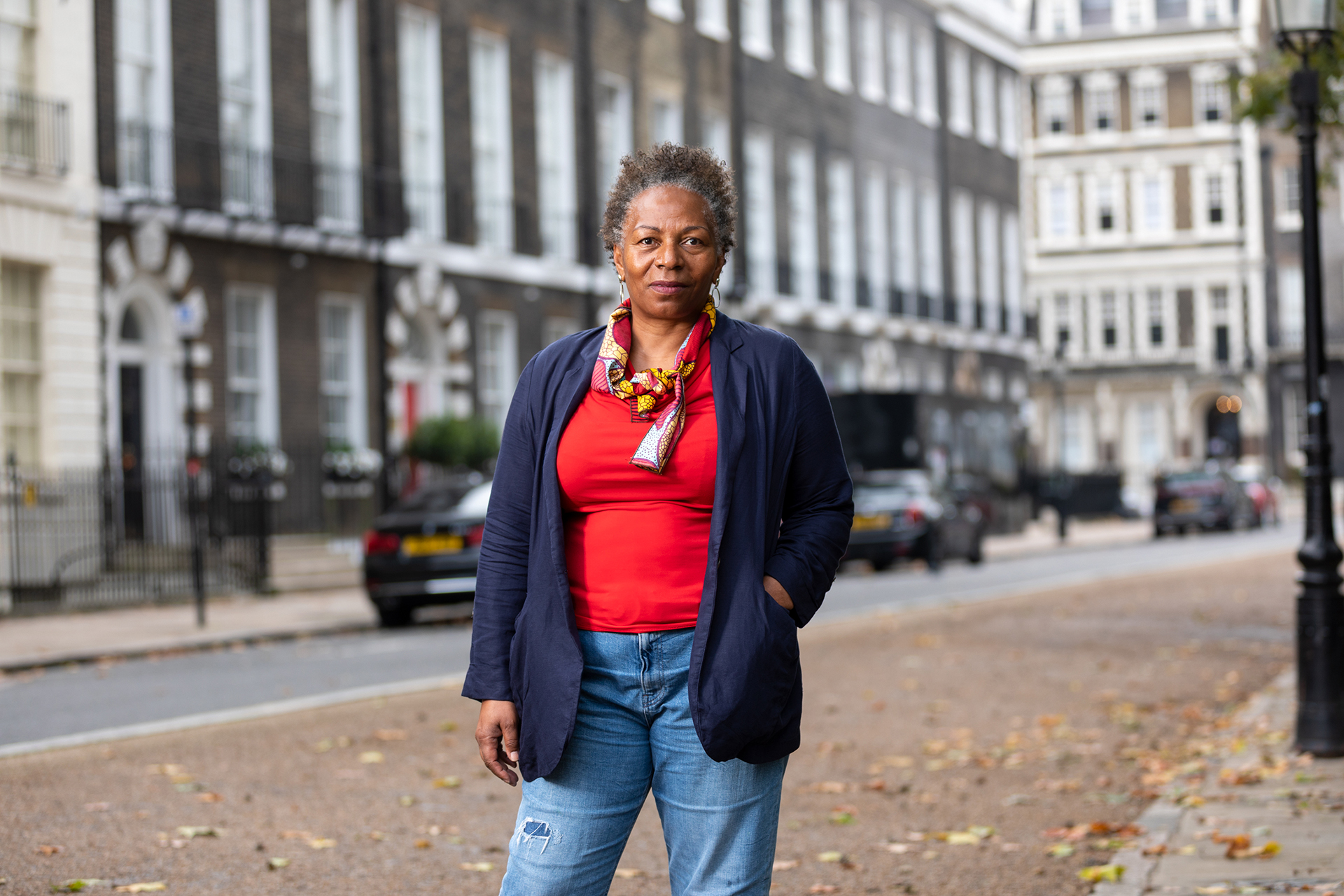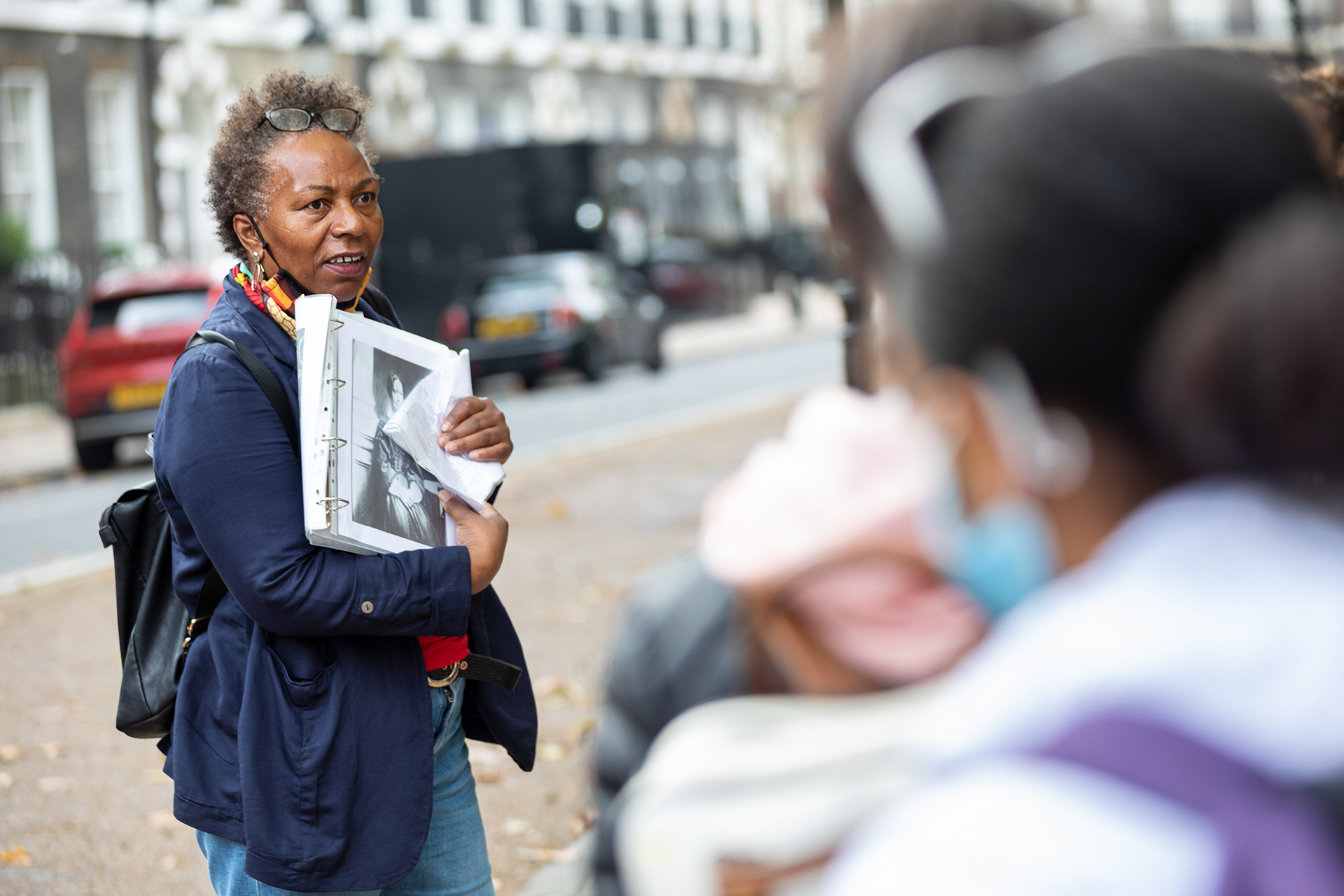Have you ever walked down a London street and wondered about the hundreds of years of stories that lie just under the surface? As part of Black History Month, London-born Shirley Fortune is hosting a walk uncovering Camden’s Black history. From activists to abolitionists, to Black Jewish and Black gay history, Shirley takes us through the rich stories that unfolded on streets we might have walked a hundred times.
“I walk around a lot, I look at buildings which may be of interest. What I’ve discovered is that there’s Black fingerprints everywhere.”

A fan of history – “My bookshelf is bursting with history books,” she says – Shirley is also a member of several walking groups, “I walk around a lot, I look at buildings which may be of interest. What I’ve discovered is that there’s Black fingerprints everywhere.” She kicked off her guiding career taking the Camden local guiding course in 2017 followed by further courses at City of Westminster College and City, University of London.
Bloomsbury isn’t an area you might necessarily associate with Black history, and that’s why it’s great place to explore through a Black history lens, as Shirley explains, “Bloomsbury is fabulous, it’s beautiful, you’ve got lovely garden squares. I do many walks there with different topics, [such as] medical, education, Because this is such a huge hit, I want to share that there are Black stories here too.”
Shirley’s favourite historical figures
One of Shirley’s favourite historical figures on the walk is Sarah Parker Remond, one of the first Black women to study in London and someone Shirley discovered when planning a walk for International Women’s Day. “She wanted to raise awareness for the Black cause in the States during the Civil War and also she was a suffragist as well,” Shirley says. Senate House Library is where we come across Mary Prince, another favourite. An abolitionist, Prince came to the country as an enslaved nursemaid and wrote The History of Mary Prince, the first narrative of a Black woman to be published in Britain.
More recent history also features, as the walk includes Marchmont Street’s Gay’s the Word, the UK’s oldest LGBT bookshop. For Shirley this is an opportunity to talk about the diversity of identity and experience of Black people, and also representation. She explains, “When my children were small, I had to join a book club to get books that would have people that looked like them. Now, I’ve got photographs of my local Foyles with loads of pictures of Black people. Children might have an option of finding a character that looks like them.”

Through the various courses and seminars Shirley attends, she ends up finding out about lesser-known aspects of Black history. The Wiener Holocaust Library in Bloomsbury is one example. “You might think, ‘why are we going there?’ but there are Black Jews and they also suffered with the Nazis.” Shirley explains there was a significant Black population in Germany at the time and they were excluded from education and employment and subjected to forced sterilisation.
Harold Moody
Friends House, the Quaker centre on Euston Road, is another space that reveals unexpected aspects of Black history: “Quakers were very early abolitionists. Another side which nobody talks about is all the women that were really quite passionate about anti-slavery,” Shirley says. Jamaican-born physician Harold Moody features on the walk and is someone who was supported in his campaigning by the Quakers. His ‘League of Coloured Peoples’ – a civil rights organisation – was founded on Tottenham Court Road in 1931.
Recontextualising local history
When quizzed on her favourite period in history, Shirley says “women’s suffrage”, before mentioning the period after the First World War. She explains: “Things were changing for working class people, for women. I like social history most of all. I think the untold stories are my favourite. I’d like to hear about the maid who worked in this big house and what happened to her. People want to hear those stories.”
By reframing and recontextualising the history of Bloomsbury and the surrounding area, Shirley is helping to instill a sense of ownership over these physical spaces. Of the people who attend her walks, Shirley says, “It’s nice that they can have pride in the fact that, ‘all this is mine, this is what my people contributed to’. When I think about the city, I like to turn the narrative. Not ‘this is what happened to us’, but ‘this is what I contributed, this is what my people did’.”
“When I think about the city, I like to turn the narrative. Not ‘this is what happened to us’, but ‘this is what I contributed, this is what my people did’.”
Highlighting Black contributions to society
A child of the Windrush generation, Shirley clearly sees the impact that wave of immigration had on London. “Every time I hit a big transport hub, I think of the contribution the post-Windrush people have made to just moving millions of people around in London, all the time.” Shirley’s walks may take in the history of slavery in this city and mentions the compensation payments made to slave owners in the UK after abolition, but she’s also keenly focused on the positive stories in Black history. “You have to remember what the country was like, what London was like after the war, it was damaged. Black people put it back together and they’re still taking us all around London, looking after us.”
Through these walks, Shirley’s aim is that people see themselves reflected in these spaces. She says she wants to “encourage people to walk around and look up, look down and question, ‘I wonder who works there? I wonder what it would have been like’”.
Take Shirley’s Bloomsbury walk
Shirley Fortune’s Black History of Camden Walk takes place on the 2nd November, tickets are £11 for adults and £2 for children.
Photo credits: Jenna Selby
